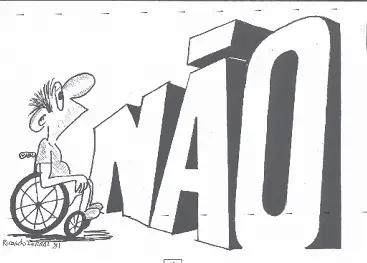Text interpretation activity, aimed at students in the ninth year of elementary school. It is a text together with a cartoon showing the relationship between the city and people with physical disabilities. From these texts, questions are addressed about this subject of social relevance. Good job, teacher! 😉 😉 😉
Download this Portuguese language activity in an editable Word template, ready to print in PDF and also the completed activity.
Download this Portuguese exercise at:
SCHOOL: DATE:
PROF: CLASS:
NAME:
Accessibility, Social Inclusion and Universal Design: Everything to See
“Accessibility is a right, not a privilege”, William Loughborough.
The dictionary tells us that “accessibility” is a noun that denotes the quality of being accessible; “accessible”, in turn, is an adjective that indicates what can be easily reached; which is within reach. In the area of Disability, when this term began to be used, it was restricted to the built environment and designated the elimination of architectural barriers. In fact, the most frequently used expression was “breaking barriers”, as it was understood that the person was referring to architectural barriers.
The feeling that people had (both people with disabilities and family, friends and professionals) was very negative: a city was seen as a dangerous place, full of traps and obstacles to be faced, which required willingness and patience, all morning. Nothing was easy, nothing was possible. Ricardo Ferraz's illustration brilliantly translates the perception and feeling of that time.

( Taken from http://apnendenovaodessa.blogspot.com.br/2011/05/como-definir-acessibilidade.html)
The answers should be:
– readable
- the pen
– complete
1) From the reading of the text and drawing in question, what do you understand by accessibility?
A:
2) According to the Aulete dictionary, architecture is the “Art and technique of designing spaces and buildings suitable for human experiences and activities”. How do you define what the author meant by “architectural barriers”?
A:
3) The author used parentheses in the second paragraph. What is their role in the construction of meaning in this part of the text?
A:
4) Do you think the city you live in has accessibility for people with certain disabilities in general? Regardless of whether your answer is positive or negative, comment briefly on your perception of it.
A:
5) In the illustration, the adverb “NO” is written quite large. What does it actually represent besides the negation value for the drawing as a whole?
A:
By André Tarragô Martins – Middle and Middle School Teacher of Portuguese Language and Master in Letters in the area of Language, Interaction and Learning Processes. In addition, he is a musician and journalist. He works in pre-university entrance exams, pre-contests, private lessons, preparation of competition tests and is content creator for the Portal www.acessaber.com.br
At answers are in the link above the header.
 report this ad
report this ad